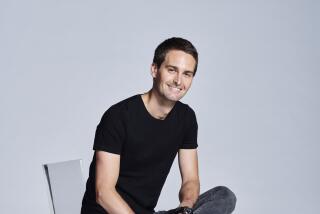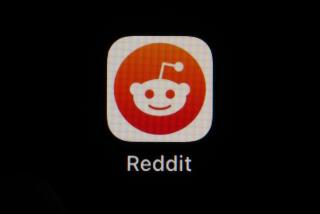Facebook to snap up Instagram photo-sharing app for $1 billion
SAN FRANCISCO â In its biggest acquisition, Facebook is paying $1 billion for the hugely popular Instagram mobile photo-sharing app maker in a move that broadens its business and absorbs a potential rival.
The tiny San Francisco startup has just 13 employees and no significant revenue. But its acquisition helps ensure that Facebook â on the verge of staging the most hotly anticipated initial public stock offering in years â will be on the forefront of how people share photos with friends on their smartphones. And it keeps Instagram out of a competitorâs clutches.
Unlike other purchases it has made, Facebookâs founder and chief executive, Mark Zuckerberg, said Instagram would continue to operate as an independent company.
âWe will try to learn from Instagramâs experience to build similar features into our other products,â Zuckerberg said. âAt the same time, we will try to help Instagram continue to grow by using Facebookâs strong engineering team and infrastructure.â
Instagram enables smartphone users to apply a large variety of retro and other looks to their photos, and then quickly email them or upload them to social media sites, such as Facebook or Twitter. Because Instagram will remain independent, its users will not have to become Facebook members.
This might be welcome news for Instagram fans, some of whom expressed their dismay Monday that Facebook was buying the company. Instagram had amassed 30 million registered users in less than two years.
âFacebook is going to buy (and screw up) Instagram for a billion bucks,â tweeted one. Others expressed concern about the privacy of their photos.
But Instagram co-founder Kevin Systrom, who will reap a $400-million payday when the deal closes â expected by the end of June â sought to reassure users that nothing about the experience would change.
âWeâll be working with Facebook to evolve Instagram and build the network,â he wrote in a blog post. âWeâll continue to add new features to the product and find new ways to create a better mobile photos experience.â
Analysts said Facebook could not afford to wait until after its IPO, which could come as soon as May, to buy Instagram, whose lightning-quick success might have eventually threatened its own.
Instagram had emerged as a potential competitor by targeting the sweet spot between smartphones and social networking. It had become the talk of Silicon Valley and had just raised $50 million in a new round of funding led by Sequoia Capital that valued the app maker at $500 million.
Other Facebook competitors were also circling, raising the possibility of a bidding war. Instagram had already rejected a previous offer from Facebook.
The acquisition announcement Monday capped a stunning rise for Instagram. Until last month, its app was available only for iPhone users. When it released a version for Android phones, it was downloaded by a million users in less than a day.
As its popularity grew, Instagram began to plan more features that would have made it more of a full-fledged social networking app. Already, celebrities such as Justin Bieber have flocked to the site, along with such marketers as Burberry and Nike, looking to promote their products.
âIt was not just a photo-sharing app. It was a way that people were communicating with each other the same way they might have on Facebook,â said Paul Kedrosky, a senior fellow at the Kauffman Foundation. âFacebook saw it as a fast-growing competitor.â
The $1-billion purchase price drew comparisons to Googleâs purchase of YouTube, and revived talk of a Silicon Valley bubble.
Instagram was founded in October 2010 by two Stanford University graduates â Systrom and Mike Krieger â who got about $500,000 in seed money from Andreessen Horowitz and Baseline Ventures.
The following February, Benchmark Capitalâs Matt Cohler, one of Facebookâs earliest employees and an Instagram board member, led a $7-million fundraising round that valued the company at more than $20 million. To date, Instagram has raised a total of $57.5 million.
Other companies playing in that space include Path and DailyBooth, but none have yet gained the kind of traction with users that Instagram did.
Mobile and photos are two areas identified by Facebook as crucial to its future. For years, photo sharing has been one of the most popular features on social networking sites. Facebook saw its engagement levels skyrocket after it began allowing users to upload photos and tag their friends. Pictures have become a simpler, faster and more expressive medium for young people to share their lives.
âIf there was any competitor that could give Zuckerberg heartburn, it was Systromâs posse,â GigaOmâs Om Malik wrote in a blog post. âIt cracked the code where Facebook itself failed: viral growth on mobile.â
More to Read
Inside the business of entertainment
The Wide Shot brings you news, analysis and insights on everything from streaming wars to production â and what it all means for the future.
You may occasionally receive promotional content from the Los Angeles Times.










